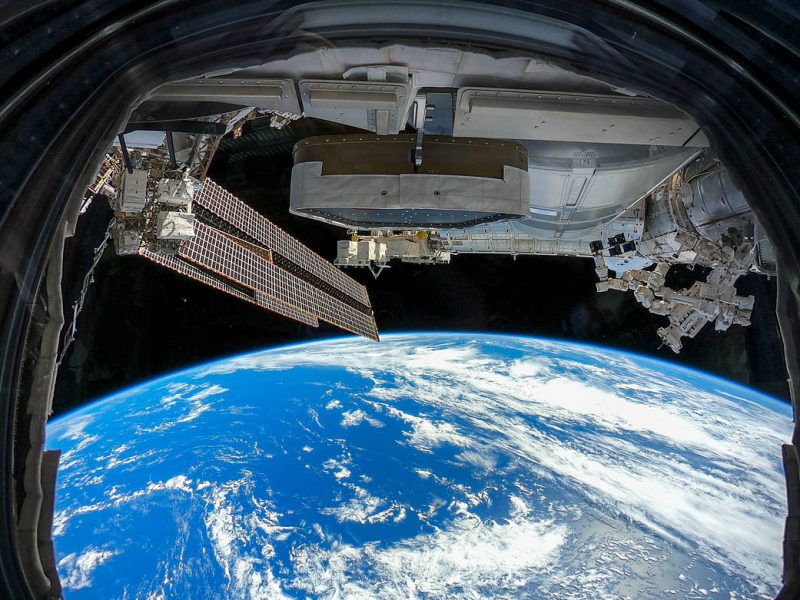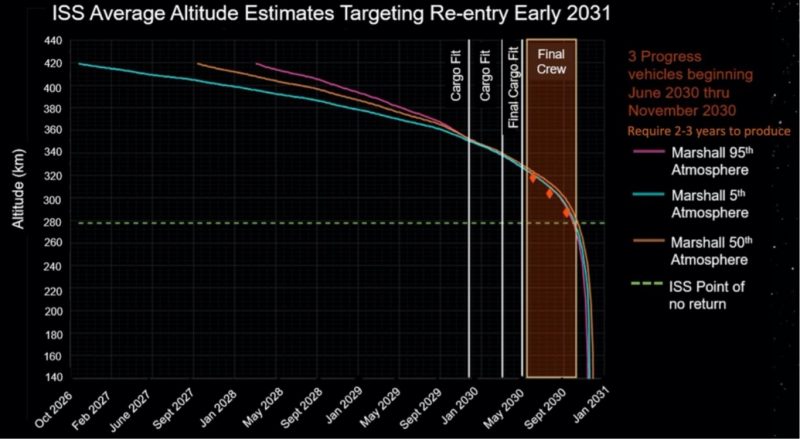
NASA’s plans for the end of ISS
The International Space Station (ISS) can’t continue forever. Its lifetime is limited by primary structures that can’t be repaired or replaced, such as modules, radiators and trusses. On January 31, 2022, NASA announced that the Biden-Harris administration had extended the space station’s operations until 2030. So as early as 2031, the space station could be guided to a fiery demise, as it de-orbits through Earth’s atmosphere. The goal would be to place it in the Pacific Ocean near what’s called Point Nemo, the point in Earth’s oceans farthest from land. That scenario is part of a report released by NASA in January 2022.
It’s titled International Space Station Transition Report and it describes the eventual plan to de-orbit the space station.
For the recent NASA report, and in a way that’s ongoing, various countries and institutions in charge of different components of ISS are assessing the health of their contributions. While the current date for the de-orbit of the space station is in 2031, any findings could push that date backward … or forward.
In order to de-orbit ISS, the space station will need a little help. It won’t have enough power to perform the necessary maneuvers alone. Three vehicles will need to help propel the space station downward into Earth’s atmosphere at the right point and moment for a safe reentry at Point Nemo.
Where is Point Nemo?
Point Nemo lies deep in the southern Pacific Ocean.
This area has the formal title of the South Pacific Ocean Uninhabited Area, but many know it best as the spacecraft cemetery.
This area is the final resting place of the Mir space station, which Russia operated in low-Earth orbit from 1986 to 2001. Six Russian Salyut stations – four that had crews for scientific research and two for military reconnaissance – also went into the spacecraft cemetery, after a program that lasted over a period of 15 years, from 1971 to 1986.
According to Wikipedia, more than 263 spacecraft between 1971 and 2016 met their fate in the spacecraft cemetery.

De-orbiting ISS: Factoring in solar activity
One major factor NASA must consider is activity from the sun’s well-known 11-year cycle. The 11 years is approximate; sometimes the cycle lasts longer or shorter. The amount of activity at the peak of each cycle also varies. And high solar activity causes Earth’s atmosphere to expand, which increases resistance or “drag” for an Earth-orbiting spacecraft. Such resistance creates a loss in altitude. The last solar cycle (Solar Cycle 24) was relatively inactive. We’re just now entering the upswing phase of Solar Cycle 25, as evidenced by an increase in sunspots and solar flares.
But no one knows how active Solar Cycle 25 will be.

ISS accomplishments, and post-ISS plans
So it’s inevitable. Like all good things, ISS won’t last forever. The first elements of the International Space Station launched in 2000. Since then, more than 200 astronauts from around the world have taken up residence there. The astronauts have undertaken countless experiments across a wide range of disciplines while on the space station.
NASA’s report also outlines its post-space-station plans. The report explains that the space agency will continue to:
– Enable deep-space exploration
– Conduct research to benefit humanity
– Foster a U.S. commercial space industry
– Lead and enable international cooperation
– Inspire humankind
In the meantime, we still have nearly a decade while the International Space Station hosts many more astronauts to make as-yet-unknown advances in science. During that time, we’ll still be able to watch in wonder as the bright, unblinking light of ISS sails overhead in our night skies.
Learn to spot the station from where you are.

Bottom line: NASA plans to crash the International Space Station into the Pacific Ocean at the end of its lifetime. This de-orbit could happen as soon as 2031.
Via NASA’s International Space Station Transition Report
The post International Space Station to crash into Pacific, as early as 2031 first appeared on EarthSky.
from EarthSky https://ift.tt/Z69iqcE

NASA’s plans for the end of ISS
The International Space Station (ISS) can’t continue forever. Its lifetime is limited by primary structures that can’t be repaired or replaced, such as modules, radiators and trusses. On January 31, 2022, NASA announced that the Biden-Harris administration had extended the space station’s operations until 2030. So as early as 2031, the space station could be guided to a fiery demise, as it de-orbits through Earth’s atmosphere. The goal would be to place it in the Pacific Ocean near what’s called Point Nemo, the point in Earth’s oceans farthest from land. That scenario is part of a report released by NASA in January 2022.
It’s titled International Space Station Transition Report and it describes the eventual plan to de-orbit the space station.
For the recent NASA report, and in a way that’s ongoing, various countries and institutions in charge of different components of ISS are assessing the health of their contributions. While the current date for the de-orbit of the space station is in 2031, any findings could push that date backward … or forward.
In order to de-orbit ISS, the space station will need a little help. It won’t have enough power to perform the necessary maneuvers alone. Three vehicles will need to help propel the space station downward into Earth’s atmosphere at the right point and moment for a safe reentry at Point Nemo.
Where is Point Nemo?
Point Nemo lies deep in the southern Pacific Ocean.
This area has the formal title of the South Pacific Ocean Uninhabited Area, but many know it best as the spacecraft cemetery.
This area is the final resting place of the Mir space station, which Russia operated in low-Earth orbit from 1986 to 2001. Six Russian Salyut stations – four that had crews for scientific research and two for military reconnaissance – also went into the spacecraft cemetery, after a program that lasted over a period of 15 years, from 1971 to 1986.
According to Wikipedia, more than 263 spacecraft between 1971 and 2016 met their fate in the spacecraft cemetery.

De-orbiting ISS: Factoring in solar activity
One major factor NASA must consider is activity from the sun’s well-known 11-year cycle. The 11 years is approximate; sometimes the cycle lasts longer or shorter. The amount of activity at the peak of each cycle also varies. And high solar activity causes Earth’s atmosphere to expand, which increases resistance or “drag” for an Earth-orbiting spacecraft. Such resistance creates a loss in altitude. The last solar cycle (Solar Cycle 24) was relatively inactive. We’re just now entering the upswing phase of Solar Cycle 25, as evidenced by an increase in sunspots and solar flares.
But no one knows how active Solar Cycle 25 will be.

ISS accomplishments, and post-ISS plans
So it’s inevitable. Like all good things, ISS won’t last forever. The first elements of the International Space Station launched in 2000. Since then, more than 200 astronauts from around the world have taken up residence there. The astronauts have undertaken countless experiments across a wide range of disciplines while on the space station.
NASA’s report also outlines its post-space-station plans. The report explains that the space agency will continue to:
– Enable deep-space exploration
– Conduct research to benefit humanity
– Foster a U.S. commercial space industry
– Lead and enable international cooperation
– Inspire humankind
In the meantime, we still have nearly a decade while the International Space Station hosts many more astronauts to make as-yet-unknown advances in science. During that time, we’ll still be able to watch in wonder as the bright, unblinking light of ISS sails overhead in our night skies.
Learn to spot the station from where you are.

Bottom line: NASA plans to crash the International Space Station into the Pacific Ocean at the end of its lifetime. This de-orbit could happen as soon as 2031.
Via NASA’s International Space Station Transition Report
The post International Space Station to crash into Pacific, as early as 2031 first appeared on EarthSky.
from EarthSky https://ift.tt/Z69iqcE

Aucun commentaire:
Enregistrer un commentaire